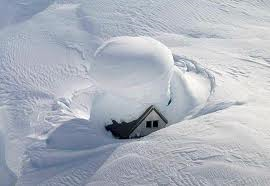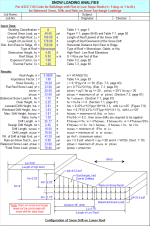ASCE705S.xls

Description
Program Description:
"ASCE705S" is a spreadsheet program written in MS-Excel for the purpose of flat roof snow loading analysis for buildings and structures per the ASCE 7-05 Code. Specifically, coefficients and related and required parameters are selected or calculated in order to compute the net design snow loads, including snow drift due on lower roofs and rain-on-snow surcharge.
Program Assumptions and Limitations:
- This program specifically follows Section 7.0, Snow Loads, of the ASCE 7-05 Standard, "Minimum Design Loads for Buildings and Other Structures".
- This program assumes only snow loading analysis for buildings with a flat roof, or low slope roof <= 5 degrees. (Note: for reference, a 1:12 roof slope equates to 4.76 degrees, and the program allows a slope up to 1.05:12.)
- This program addresses only balanced snow loading, snow drifts on lower roofs, and rain-on-snow surcharge loading. Unbalanced roof snow loads are not considered.
- This program assumes the possibility of either leeward or windward snow drifts, and the larger of the two calculated drift heights per the code is used as the design drift height. Leeward drift results from snow blown off a high roof onto a lower roof. Windward drift results from snow blown against a projection or wall below a high roof.
- This program determines any rain-on-snow surcharge loading when applicable. Rain-on-snow surcharge loading of 5 psf is not required for ground snow loads, pg > 20 psf, nor for roof slopes (in degrees) >= W/50, where "W" is equal to the horizontal distance (in feet) from the eave to the ridge on the building. This program conservatively combines the rain-on-snow surcharge loading with snow drift loading. However, per Code, rain-on-snow surcharge loading need not be combined (superimposed) with snow drift loading.
- This program contains numerous “comment boxes” which contain a wide variety of information including explanations of input or output items, equations used, data tables, etc. (Note: presence of a “comment box” is denoted by a “red triangle” in the upper right-hand corner of a cell. Merely move the mouse pointer to the desired cell to view the contents of that particular "comment box".)
Useful Web Resource
I was given a couple of websites which you might find convenient for determining the basic wind speed and ground snow load
for any location in the continental United States per the ASCE/SEI 7-05 Code, so I thought I'd pass them along.
The website links are as follows:
http://www.windspeedbyzip.com/
http://www.groundsnowbyzip.com/
You must register to make use of either website, but you only have to register at one, not both of the websites.
Once you register at one of them, you will automatically have access to information from the other one.
The two websites allow you to input either the street/city/state address or just the zip code.
The resulting location latitude and longitude are given. Regular (street), satellite, and hybrid maps are available as well.
Calculation Reference
ASCE 7-05 Code Snow Load
Calculation Preview
Full download access to any calculation is available to users with a paid or awarded subscription (XLC Pro).
Subscriptions are free to contributors to the site, alternatively they can be purchased.
Click here for information on subscriptions.
I have made the appropriate cell reference correction, and the version of this workbook is now 1.6.
Below is the logic that I have used for the revised worksheet from the second paragraph of ASCE 7-05 Section 7.7.1.
I don't know about the rest of you, but to me that paragraph typifies some of the confusing and convoluted verbiage that is often found in building codes.
hd(max) = maximum of (hdL or hdw)
If hd(max) <= hc then w = 4*hd(max) and hd = hd(max) (where hc = clear height)
If hd(max) > hc then w = 4*hd(max)^2/hc and hd = hc
The current version is now 1.5.
I have corrected that comment box, and the current version of this workbook is now version 1.4.
I was given a couple of websites which you might find convenient for determining the basic wind speed and ground snow load
for any location in the continental United States per the ASCE/SEI 7-05 Code, so I thought I'd pass them along.
The website links are as follows:
http://www.windspeedbyzip.com/
http://www.groundsnowbyzip.com/
You must register to make use of either website, but you only have to register at one, not both of the websites.
Once you register at one of them, you will automatically have access to information from the other one.
The two websites allow you to input either the street/city/state address or just the zip code.
The resulting location latitude and longitude are given. Regular (street), satellite, and hybrid maps are available as well.
At some point I will just drop the ASCE798.xls workbook, since most folks are probably using either the ASCE 7-05 or ASCE 7-02 Codes in their work.
For now I have made the corrections to the sketches in all three workbooks, and they are all now version 1.3.
I have made the correction and the workbook is now version 1.2.
With clarification received and passed on to me from one of the guys who posed these questions to the ICC, they stated that there was really no intent in the revisions made to the ASCE 7-05 Code to increase the balanced snow loading when considering rain-on-snow surcharge from what the ASCE 7-02 produced. An excerpt of that question and answer clarification received from the ICC is shown below.
A2. Not to our knowledge.
In summary, it appears that the only real change in snow loading using ASCE 7-02 versus ASCE 7-05 is the roof slope criteria for when to consider rain-on-snow surcharge. In ASCE 7-02, it applied only to roof slopes of less that 1/2" per foot, whereas in ASCE 7-05 it applies to roof slopes of less than W/50 degrees.
I have made the necessary revisions, and the "'ASCE705S.xls" workbook is now version 1.1.



Thus, for this special case I had to create another result, in the form of the weight of the snow drift at the low end (minimum value). Please note that for this rather rare case, the illustration shown at the bottom of the calculation sheet will not actually depict the snow drift value at the low end (edge of building) correctly. Sorry, there's really not an easy nor convenient way to address that particular case, and to me it's not worth the effort trying to address it. The user will just have to be aware of it.
This workbook is now version 1.7.